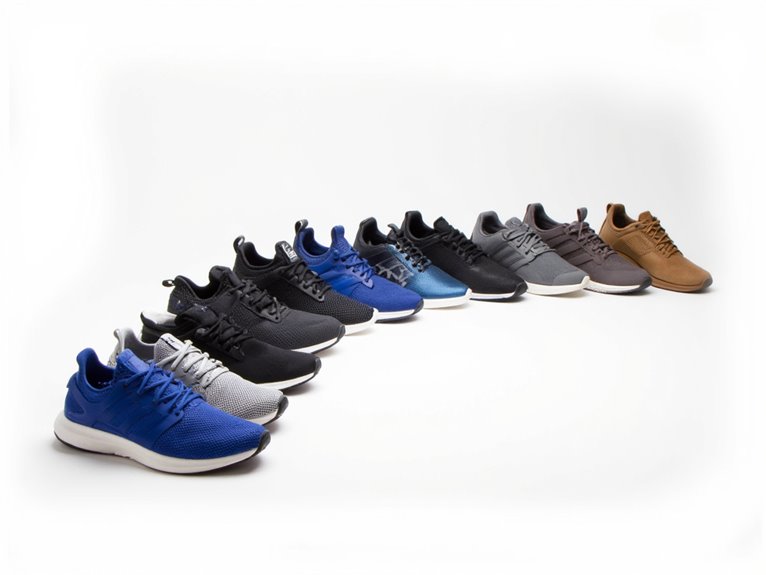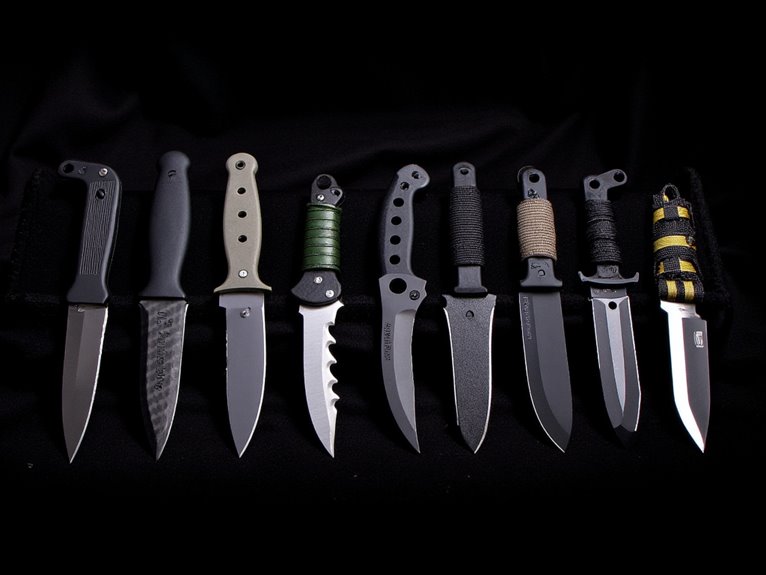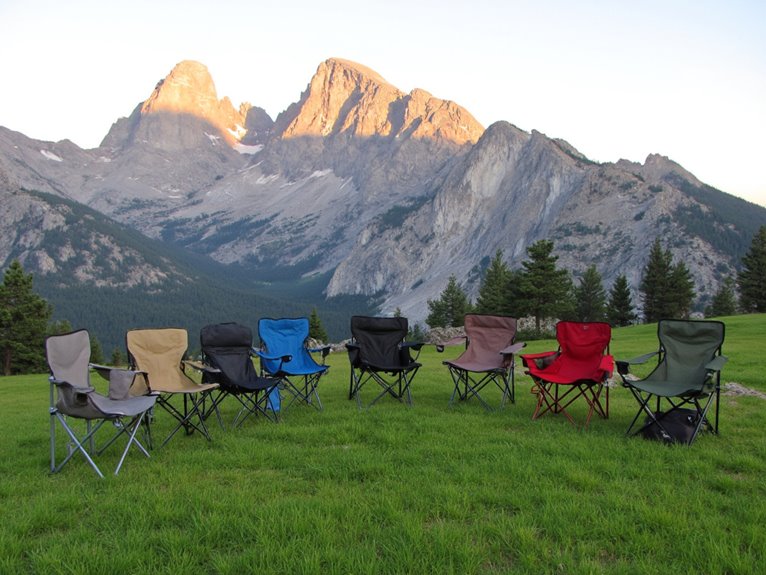10 Best Lightweight Backpacks for Travel and Daily Use
I’ve tested dozens of lightweight backpacks, and the top performers weigh under 1.5 pounds while offering 20-45 liter capacity. The MIYCOO 45L weighs just 12.8 ounces with IPX4 waterproofing, while the Osprey Ultralight compresses to wallet size at 5.2 ounces. ZOMAKE’s 30L model provides seven compartments in a 0.74-pound package, and WATERFLY’s offerings feature tear-resistant nylon with reinforced stress points. Each excels in specific scenarios, from ultralight travel to daily commuting, with detailed specifications below.
We are supported by our audience. When you purchase through links on our site, we may earn an affiliate commission, at no extra cost for you. Learn more. Last update on 9th December 2025 / Images from Amazon Product Advertising API.
Notable Insights
Lightweight backpacks weigh 1-3 pounds with 30-65 liter capacity and support loads of 25-35 pounds optimally.
Dyneema composite fabric offers 15 times steel’s strength while providing zero water absorption and UV resistance.
Proper fit requires matching torso length to pack’s adjustable range with total weight under 20% body weight.
- Ultra-lightweight options like Osprey Ultralight (5.2 oz) and G4Free (6.1 oz) offer maximum portability without sacrificing functionality.
- Packable designs from MIYCOO and WATERFLY compress into small pouches, making them ideal for travelers needing collapsible storage solutions.
- Multi-compartment organization in ZOMAKE 30L (7 compartments) and WATERFLY (6 compartments) provides efficient storage for electronics and gear.
- Water-resistant materials with reinforced stress points ensure durability for daily commuting and outdoor activities in various weather conditions.
- Capacity ranges from 18-45 liters accommodate different needs, from minimalist day trips to extended travel requiring additional storage space.
MIYCOO Ultra Lightweight Packable Backpack for Travel Camping (45L Hiking Back Pack)
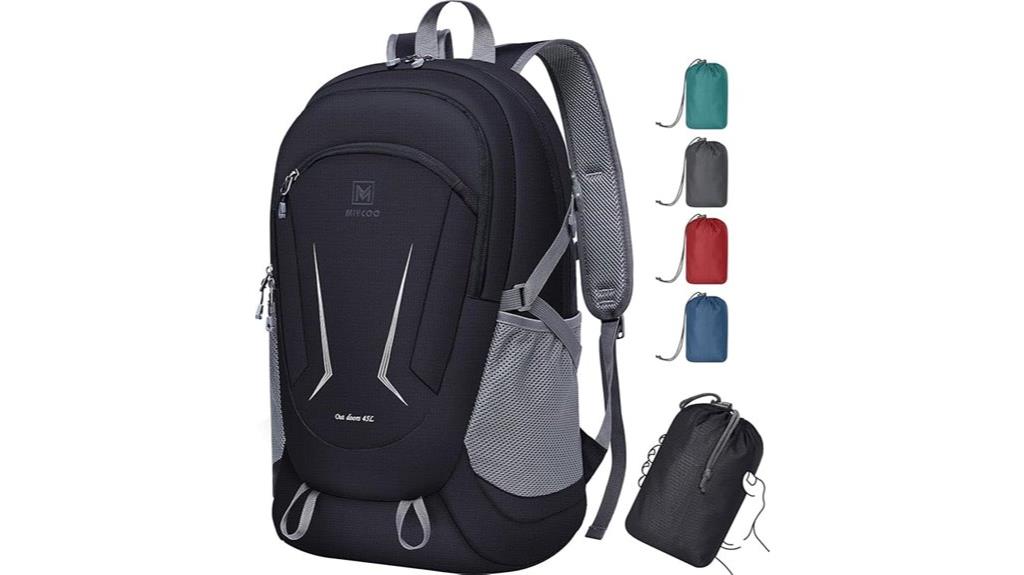
The MIYCOO Ultra Lightweight Packable Backpack delivers exceptional portability for travelers who prioritize minimal weight without sacrificing storage capacity. At just 12.8 ounces, it weighs half as much as your smartphone yet expands to 45 liters. You’ll get three compartments, including a dedicated wet section for separating damp items. The pack measures 15.9 x 9.6 x 22.4 inches when expanded and compresses to 4.9 x 3.9 x 7.8 inches for storage. Its IPX4-rated waterproof fabric protects against splashes, while heavy-duty zippers guarantee durability. Keep loads between 2-3 pounds for ideal comfort since the shoulder straps lack padding. You’ll find the integrated survival whistle useful for emergencies.
Best For: Ultralight travelers, day hikers, and outdoor enthusiasts who need a compact, packable backup bag for carrying light loads and emergency essentials.
Pros:
- Ultra-lightweight at only 12.8 ounces with impressive 45L capacity when expanded
- Highly packable design compresses to pocket size (4.9 x 3.9 x 7.8 inches) for easy storage
- Waterproof IPX4-rated fabric with three compartments including wet/dry separation and emergency whistle
Cons:
- Limited to very light loads (2-3 pounds) due to unpadded shoulder straps
- Difficult to re-stuff back into the attached carry bag according to user feedback
- Not suitable for heavy-duty hiking or carrying substantial gear loads
ZOMAKE Ultra Lightweight Hiking Backpack 20L (Water Resistant Daypack)

Weighing just 0.5 pounds, the ZOMAKE Ultra Lightweight Hiking Backpack 20L stands out as the ideal choice for minimalist travelers who prioritize packability without sacrificing functionality. You’ll appreciate its compact folding dimensions of 6.7 x 6.7 x 1.97 inches, allowing easy storage in luggage or handbags. The 20-liter capacity provides sufficient space for day trips while maintaining ultralight specifications.
You’ll find the nylon construction delivers water resistance and tear protection through reinforced double-layered stitching. The ergonomic design includes strategic pocket distribution: main compartment for clothing, front pocket for electronics, and dual side pockets for bottles. SBS metal and resin zippers prevent snagging during frequent use. With 18,055 customer ratings averaging 4.6 stars, this backpack ranks #3 in hiking daypacks, proving its reliability for various outdoor activities.
Best For: Minimalist travelers, day hikers, and outdoor enthusiasts who need an ultralight, packable backpack for short trips and activities where weight and storage space are primary concerns.
Pros:
- Extremely lightweight at only 0.5 pounds with ultra-compact folding size for easy storage
- Durable construction with reinforced stitching, quality zippers, and water-resistant nylon material
- Well-organized design with multiple compartments and pockets for efficient gear distribution
Cons:
- Water-resistant only, not completely waterproof for heavy rain conditions
- Side pockets may be too small to accommodate larger water bottles
- Limited 20-liter capacity may be insufficient for longer hiking trips or extensive gear needs
ZOMAKE Lightweight Packable Backpack 30L (Dimgray)
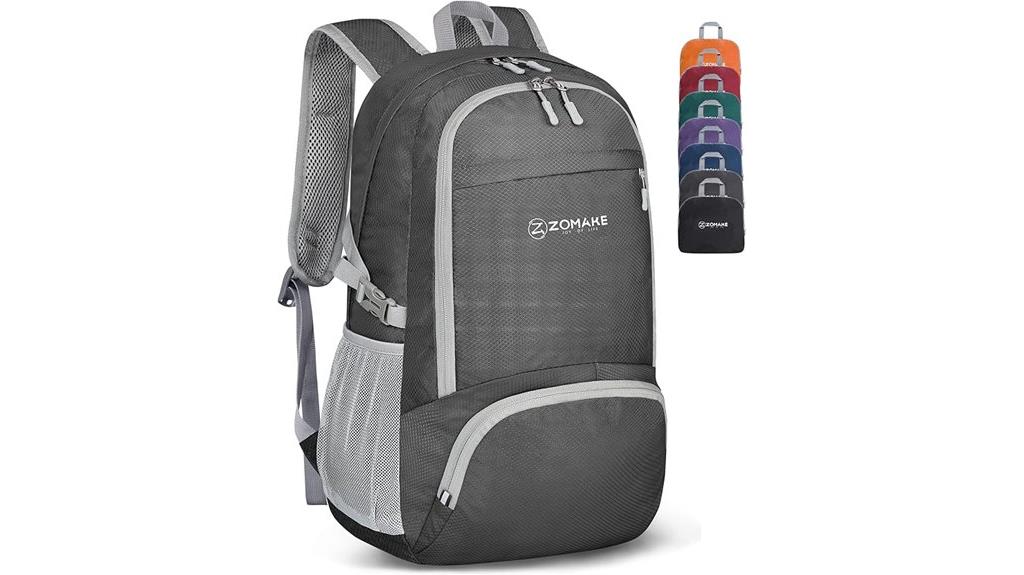
Frequent travelers and outdoor enthusiasts will find the ZOMAKE Lightweight Packable Backpack 30L (Dimgray) delivers exceptional portability without sacrificing storage capacity. At just 0.74 pounds, this 30-liter backpack measures 19×13×7 inches when expanded and compresses to 10×8×3 inches for storage. You’ll appreciate the nylon construction that provides water and tear resistance through double-layered wear-resistant processing. The design includes seven compartments: main compartment, inner partition, two front bags, two side bags, and one privacy pocket. Two-way SBS metal zippers prevent sticking during heavy use. Safety features include chest protection buckle, emergency whistle, and reflectors for low-light visibility.
Best For: Frequent travelers, outdoor enthusiasts, and daily commuters who need a versatile, ultra-lightweight backpack that can fold compactly for storage while providing ample organization with multiple compartments.
Pros:
- Extremely lightweight at 0.74 pounds yet offers generous 30L capacity with seven separate compartments for optimal organization
- Folds down to compact 10×8×3 inches for easy storage and travel convenience
- Enhanced safety features including emergency whistle, chest protection buckle, and reflective elements for visibility
Cons:
- Water-resistant but not completely waterproof, limiting protection in heavy rain conditions
- Nylon construction may be less durable than premium materials for heavy-duty outdoor use
- Lack of padded laptop compartment may limit functionality for business or student use
WATERFLY Lightweight Packable Hiking Backpack (30L Foldable Travel Daypack)
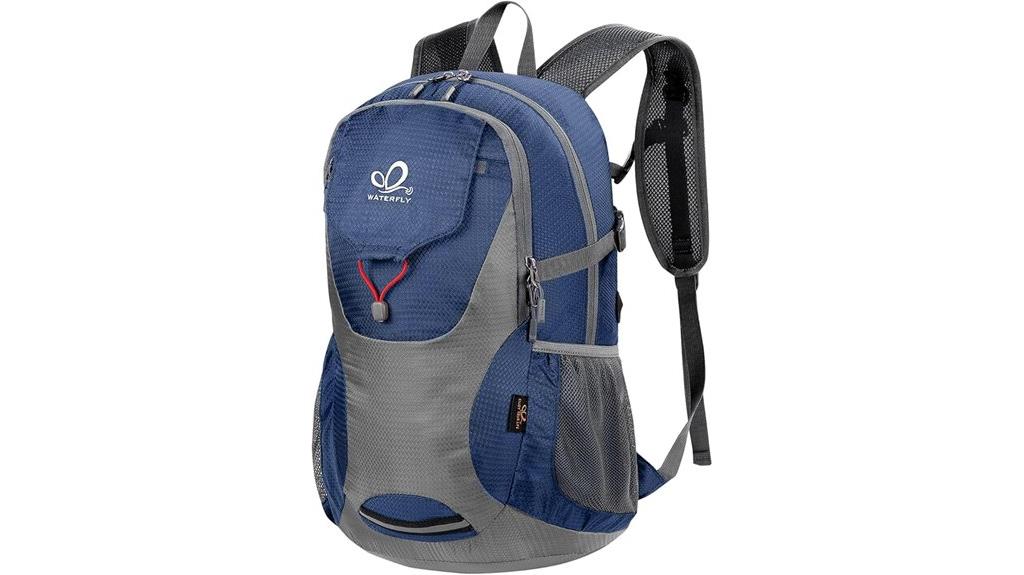
Packability defines the WATERFLY Lightweight Packable Hiking Backpack‘s core advantage, making it the ideal choice for travelers who need maximum versatility without sacrificing luggage space. You’ll compress this 30-liter pack from 19.3 x 12.5 x 8.6 inches down to just 7.5 x 7.9 x 1.97 inches. At 420 grams, it won’t strain your shoulders during extended use. The tear-resistant nylon construction includes reinforced stress points and SBS zippers rated for -40℃ temperatures. You get six storage compartments: main compartment, front pocket, two side pockets, hidden pouch, and waterproof wet pocket. S-shaped breathable shoulder straps and adjustable chest buckle optimize weight distribution for day-long comfort.
Best For: Travelers, hikers, and outdoor enthusiasts who need a lightweight, space-saving daypack that can fold down for easy packing while offering 30 liters of storage capacity for day trips and activities.
Pros:
- Ultra-packable design folds down to just 7.5 x 7.9 x 1.97 inches, making it perfect for travel storage
- Lightweight at only 420 grams with durable tear-resistant nylon and reinforced stress points
- Six well-organized compartments including a waterproof wet pocket and internal charging cable port
Cons:
- Some users report comfort issues with the shoulder straps during extended wear
- Limited organizational features with fewer zipper pockets than some users prefer
- May lack the structural support needed for heavier loads or technical hiking applications
G4Free 20L Lightweight Packable Travel Hiking Daypack

When you need a backpack that disappears into your luggage but expands to full functionality at your destination, the G4Free 20L Lightweight Packable Travel Hiking Daypack delivers exceptional versatility at just 6.1 ounces. This minimalist design folds into its built-in pouch, shrinking to sandwich size for effortless transport.
The polyamide construction offers water and tear resistance while SBS zippers provide reliable closure. Reinforcement at 14 critical stress points enhances durability. You’ll get three zippered compartments within the 16.5 x 11.8 x 6.3-inch unfolded dimensions. The wide S-shaped shoulder straps feature breathable mesh padding.
This daypack meets airline personal item requirements and excels across multiple activities.
Best For: Travelers, hikers, and commuters who need an ultra-lightweight backup daypack that folds into minimal luggage space but expands to 20 liters when needed.
Pros:
- Extremely lightweight at only 6.1 ounces while offering 20L capacity and folds to sandwich size
- Durable construction with water-resistant polyamide material, SBS zippers, and reinforcement at 14 stress points
- Meets airline personal item requirements and versatile for travel, hiking, shopping, and daily use
Cons:
- Colors may run when exposed to wet conditions according to customer feedback
- Some customers report missing or unclear folding instructions
- Made in China which may concern buyers preferring domestic manufacturing
THE NORTH FACE Borealis Commuter Laptop Backpack
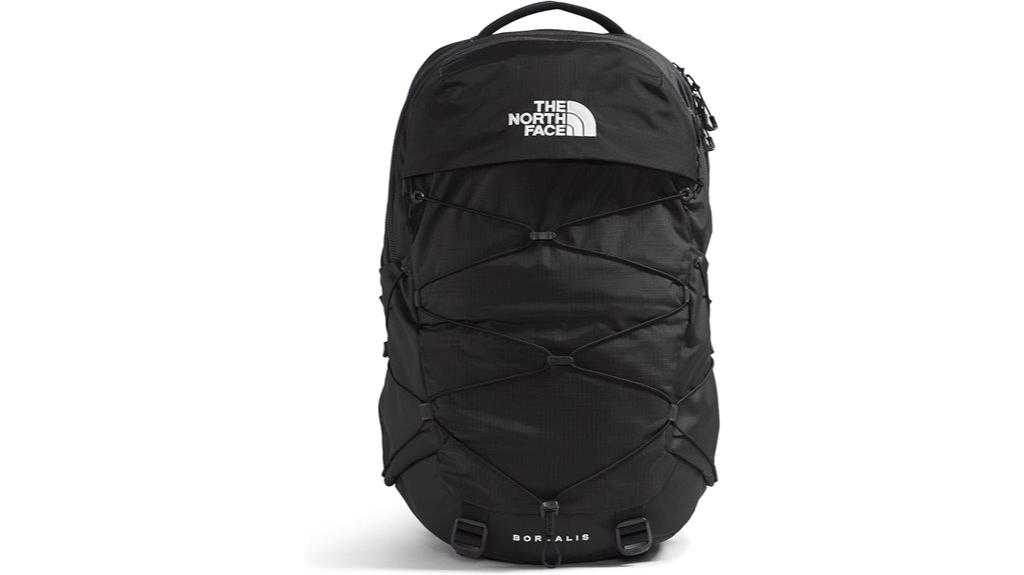
Students and commuters who demand exceptional organization will find their perfect match in THE NORTH FACE Borealis Commuter Laptop Backpack. This 28-liter pack measures 12 x 6.5 x 19.5 inches and weighs 2 pounds 5 ounces. You’ll appreciate the FlexVent Suspension System featuring articulated shoulder straps and rounded back panel for comfort. The laptop sleeve accommodates 13.75 x 11.25-inch devices, while the fleece-lined electronics pocket protects smaller items. Multiple compartments include external water bottle pockets and an organized admin section. However, you should note some users report top-heavy tendencies and limited daily storage capacity despite the pack’s thorough organization features.
Best For: Students and commuters who prioritize organization and comfort features over maximum storage capacity.
Pros:
- FlexVent Suspension System with articulated shoulder straps and rounded back panel provides exceptional comfort during extended wear
- Comprehensive organization with multiple compartments including fleece-lined electronics pocket, padded laptop sleeve, and admin section
- High-quality construction featuring waterproof exterior, YKK zippers, and 360-degree reflective details for durability and safety
Cons:
- Top-heavy design causes the backpack to tip over when set down due to front lip structure
- Limited daily storage capacity despite 28-liter volume may not meet needs of users requiring extensive gear
- Higher price point compared to competitors offering similar or greater storage volume
Osprey Ultralight Collapsible Stuff Pack, Black
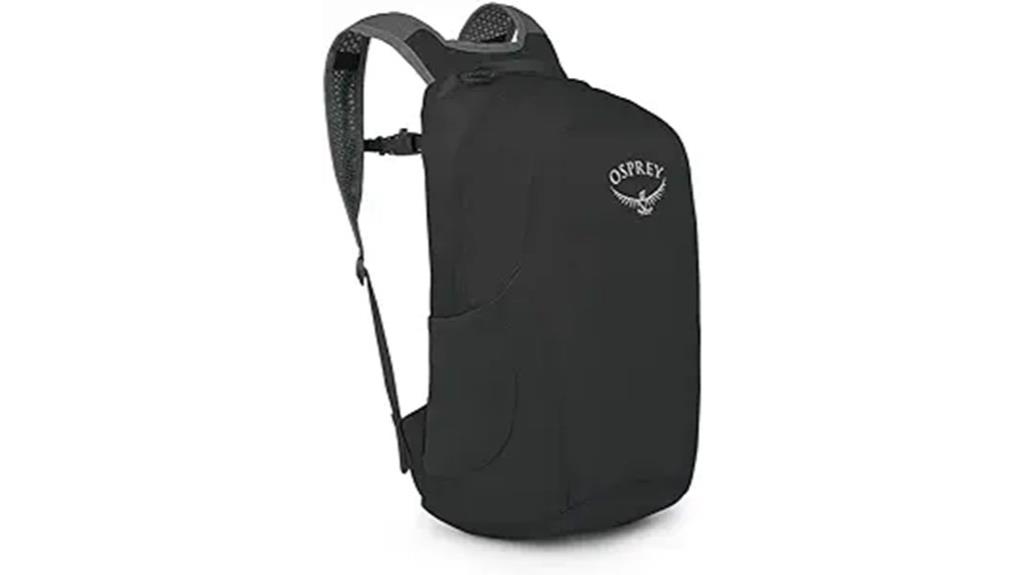
The Osprey Ultralight Collapsible Stuff Pack transforms from a wallet-sized bundle into an 18-liter daypack, making it essential gear for travelers who can’t predict their daily storage needs. You’ll appreciate its 5.2-ounce weight and 2 x 6 x 5-inch packed dimensions. The pack’s 100% recycled fabric meets Bluesign approval standards while maintaining durability.
You won’t find internal organization compartments, which means your items will shift together during transport. The lightweight straps provide basic functionality but lack substantial padding. You’ll find the key clip and top grab handle useful for quick access situations.
This pack excels during international travel when you need unexpected storage capacity. It dries quickly after washing and handles shopping trips effectively. The 4.7-star rating from 825 customers confirms its reliability for day excursions and gear transport.
Best For: Travelers and hikers who need an ultra-portable backup daypack that can compress to wallet size when not in use.
Pros:
- Extremely lightweight at 5.2 ounces and compacts to wallet size for easy packing
- Made from 100% recycled, Bluesign-approved materials with excellent durability
- Generous 18-liter capacity that’s perfect for day trips, shopping, or carrying extra gear
Cons:
- Lacks internal organization compartments, causing items to shift and lump together
- Lightweight straps provide minimal padding and may feel flimsy during extended use
- No internal structure makes packing and organizing items more challenging
WATERFLY Small Lightweight Packable Backpack (20L Ultra Light Foldable Travel Daypack)

Packable backpacks solve one critical problem for travelers: luggage space. The WATERFLY Model Onj01 folds from 16.9×11.4×5.5 inches down to a compact 8.7×6.3-inch package. You’ll appreciate its 10.2-ounce weight—lighter than most water bottles. This 20-liter daypack features recycled nylon construction with polyester linings and SBS zippers for smooth operation. The multi-compartment design includes one main pocket, two front pockets, one removable zipper pocket, and side mesh bottle holders. You can use it for hiking, cycling, or daily commutes. Limited back padding means it’s best for lighter loads. Customer ratings average 4.5 stars across 2,809 reviews.
Best For: Travelers and outdoor enthusiasts who need an ultra-lightweight, space-saving daypack for light loads during hiking, cycling, or daily commutes.
Pros:
- Extremely lightweight at 10.2 ounces and folds down to a compact 8.7×6.3-inch package for easy storage
- Multi-compartment design with main pocket, front pockets, removable zipper pocket, and side mesh bottle holders
- Made from durable recycled nylon with smooth-operating SBS zippers and carries a 4.5-star rating
Cons:
- Limited back padding makes it uncomfortable for heavier loads or extended wear
- Some customer concerns about fabric durability when carrying heavier items
- Lacks additional features that some users might expect from outdoor gear
JanSport SuperBreak One Backpack – Lightweight with Front Utility Pocket, Black
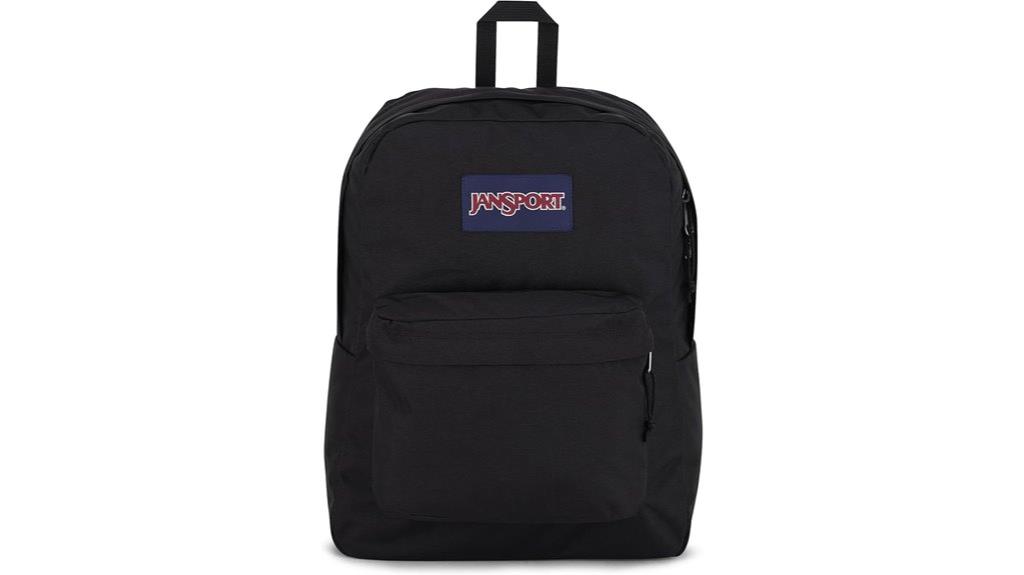
Modern adventurers who prioritize weight savings without sacrificing functionality will find the JanSport SuperBreak One backpack delivers exceptional value for daily travel and exploration. At just 10.6 ounces, this pack weighs 40% less than traditional daypacks while maintaining a generous 25.3-30 liter capacity. You’ll appreciate the durable 100% recycled 600-denier polyester construction that resists abrasion and repels water effectively.
The streamlined design features one main compartment plus a front utility pocket with built-in organizer for essential items. Measuring 17 x 12.5 x 6 inches, it accommodates standard travel gear without bulk. Padded shoulder straps distribute weight evenly across your back, while the reinforced web handle enables quick carrying shifts. Over 43,000 customers rate this pack 4.6 stars, confirming its reliability for everyday adventures.
Best For: Students, daily commuters, and lightweight travelers who need a reliable, eco-friendly backpack with essential organization features for books, school supplies, and everyday carry items.
Pros:
- Exceptionally lightweight at only 10.6 ounces while offering 25.3-30 liter capacity for maximum functionality
- Made from durable, water-repellent 100% recycled polyester with reinforced construction and quality zippers
- Highly rated by over 43,000 customers with 4.6 stars and backed by JanSport’s proven reliability since 1967
Cons:
- Limited compartment options with only one main section and front pocket may not suit users needing extensive organization
- No dedicated laptop compartment or padding for electronics protection
- Minimal internal organization features compared to more specialized backpacks
G4Free 40L Lightweight Packable Hiking Backpack, Waterproof Travel Daypack
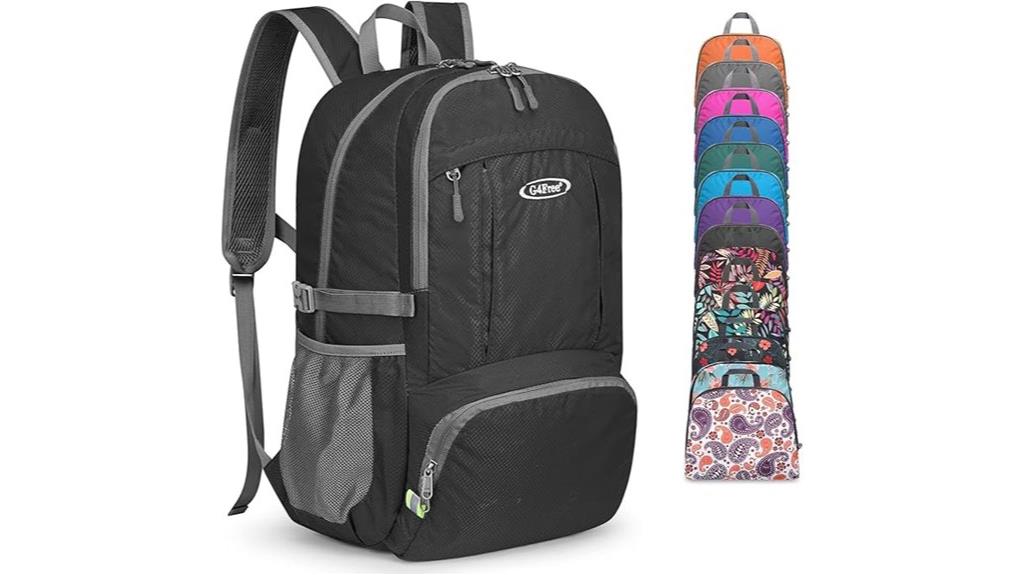
Budget-conscious travelers who need a versatile backup bag will find exceptional value in the G4Free 40L Lightweight Packable Hiking Backpack. This water-resistant pack folds into a compact pouch that fits easily in your suitcase. You’ll appreciate the 40-liter capacity with multiple zippered compartments for organized packing. The adjustable straps and chest buckle distribute weight evenly during all-day wear. Users report three-plus years of heavy use without zipper failures or fabric tears. You can use it as a carry-on bag, day pack for hiking, or college backpack. The packable design makes it perfect as an emergency travel bag.
Best For: Budget-conscious travelers, students, and outdoor enthusiasts who need a durable, versatile backpack that can serve multiple purposes from hiking and travel to daily college use.
Pros:
- Exceptional durability with 3+ years of heavy use reported without rips, tears, or zipper failures
- Versatile packable design that folds into a compact pouch, perfect for use as a backup travel bag or carry-on
- Comfortable all-day wear with adjustable straps, chest buckle, and 40L capacity with multiple organized compartments
Cons:
- Only water-resistant rather than fully waterproof, limiting protection in heavy rain conditions
- May lack the advanced features and premium materials found in higher-end hiking backpacks
- Limited color and style options compared to more fashion-focused backpack brands
Factors to Consider When Choosing a Lightweight Backpack
When you’re evaluating what defines a lightweight backpack, the primary distinction lies in its weight-to-volume ratio and stripped-down design philosophy. These packs typically weigh 1-3 pounds and range from 30-65 liters capacity.
Design principles focus on eliminating non-essential features like excess zippers, padded components, and heavy frame systems. You’ll find frameless or minimal frame construction that supports loads up to 25-35 pounds maximum. The body weight ratio approach suggests keeping your total pack weight at or below 15% of your body weight for optimal performance.
Materials include Dyneema Composite Fabric and Ultra High Molecular Weight Polyethylene for ideal strength-to-weight ratios. Roll-top closures replace traditional zippers to reduce hardware weight.
User experiences emphasize selective gear choices and compressed packing techniques. Single main compartments with minimal exterior pockets force strategic organization. Lightweight backpacks contribute significantly to achieving an ultralight base weight under 4.5kg, which excludes worn items and consumables like food and water.
This minimalist approach requires adapting your hiking style to work within the pack’s weight and volume limitations.
Weight and Packability
When you’re selecting a lightweight backpack, understanding ultralight weight standards becomes essential for optimizing your gear system.
The ultralight threshold sits at 4.5 kg (9.9 lb) base weight, while super ultralight backpackers push this limit below 5 pounds total.
You’ll need to balance your pack’s capacity against its weight, as larger volumes typically mean heavier materials and additional features that can compromise your ultralight goals. For optimal performance during day hikes, your total carry weight should remain around 10% of body weight to maintain comfort and mobility. The availability of lightweight gear has grown substantially, with options now available from nearly 100 companies specializing in ultralight equipment.
Packability offers equal importance for travelers. The best lightweight backpacks fold into compact sizes, often fitting into your pocket or existing luggage. This feature proves invaluable when you need extra storage space during your trip or want to pack a backup bag without consuming precious suitcase real estate.
Modern lightweight materials like durable nylon achieve this remarkable weight reduction without sacrificing performance. These fabrics maintain water resistance and tear strength while cutting ounces from your total carry weight, making extended travel considerably more comfortable.
Capacity and Size
Capacity selection determines how effectively your lightweight backpack serves your specific travel needs, with options spanning from compact 20-liter models to spacious 45-liter designs. I recommend 20L packs for minimal day trips and urban environments where you’ll carry essentials like water, snacks, and electronics. For extended day hikes or travel requiring additional gear, 45L models provide necessary storage space.
Size directly correlates with volume, making dimensional measurements vital for fitting airline carry-on restrictions and personal storage requirements. The best lightweight packs compress dramatically when empty—quality models fold to approximately 4.9 x 3.9 x 7.8 inches for effortless transport. Consider both unfolded dimensions for active use and compressed size for storage convenience. This dual-size capability maximizes versatility while maintaining the packability that defines truly effective lightweight travel gear.
You’ll find ultralight designs sacrifice organizational features for minimal weight, while traditional packs include more pockets and support systems. The weight difference between ultralight and traditional framed packs can significantly affect your hiking comfort over long distances.
Consider your comfort threshold when selecting capacity-to-weight ratios for peak performance. An appropriately sized pack allows you to fit all gear inside, avoiding external straps that can compromise load stability and balance during your hike.
Material and Durability
Three primary material categories define lightweight backpack construction: ripstop nylon, polyester blends, and recycled fabric composites. I recommend high-quality nylon for its superior tear resistance and durability under stress. Polyester offers excellent water resistance while maintaining lightweight properties.
You’ll find ultralight packs weighing 0.15 to 1 pound require careful material selection. I prioritize reinforced stitching and YKK zippers, which prevent failure during frequent use. These components directly impact longevity and performance.
Water resistance ratings matter considerably for outdoor conditions. Look for fabrics with waterproof coatings that protect contents during light rain or splashes. Recycled materials like Prolypropylene and BODY fabrics provide environmental benefits without compromising strength.
Balance weight against durability carefully. The lightest materials aren’t always strongest, so evaluate your specific usage requirements before selecting.
Dyneema composite fabric offers the highest strength-to-weight ratio available, delivering exceptional tensile strength while weighing considerably less than traditional materials.
Ripstop nylon provides an excellent balance of durability and weight savings, featuring reinforced grid patterns that prevent small tears from spreading across the fabric. Ultra fabrics launched by Challenge Sailcloth offer enhanced abrasion resistance compared to traditional Dyneema options while maintaining competitive weight and pricing.
Water-resistant materials help protect your gear during unexpected weather conditions while adding minimal bulk to your pack’s overall weight profile.
Compartment Organization Features
Smart compartment organization transforms a lightweight backpack from a simple carrying vessel into an efficient travel system. I recommend selecting backpacks with multiple zippered compartments that create distinct storage zones for different items.
Main compartments should accommodate larger gear, while front utility pockets handle smaller essentials. Side pockets prove essential for water bottles and quick-access items. I prioritize specialized features like wet compartments that separate damp clothing from dry items during varied weather conditions.
Modern designs incorporate cable management holes for device charging and built-in organizers within front pockets. These features enhance security and accessibility. Ergonomic pocket distribution reduces shoulder strain by balancing weight across the pack’s frame. Quick-access compartments improve convenience during outdoor activities when you can’t remove the entire backpack.
Comfort and Fit
While compartment organization maximizes storage efficiency, proper comfort and fit determine whether you’ll actually enjoy carrying your lightweight backpack during extended travel. I prioritize adjustable S-shaped breathable mesh shoulder straps that conform to your body’s natural curves. These straps redistribute weight evenly across your shoulders, preventing pressure points during long walks.
The torso length notably affects comfort. Most quality backpacks offer adjustable torso sizing from 16 to 21 inches. Padded back panels create airflow channels that reduce heat buildup and moisture retention. I recommend backpacks with adjustable chest buckles positioned between your collarbone and sternum. This stabilizes the load and prevents shoulder strap slippage. Weight distribution becomes critical when carrying loads exceeding 15 pounds, making proper fit essential for preventing fatigue and maintaining proper posture throughout your journey.
Consider these key factors when evaluating trade-offs:
1. Pack weight impact: Every 10-15% weight difference becomes noticeable after 8+ hours of hiking.
2. Personal tolerance levels: Your experience with different pack styles influences comfort perception greatly.
3. Packing efficiency: Ultralight designs demand precise gear organization and may limit carried items.
Trial error with various models helps determine your optimal balance. A 2.5-pound comfortable pack often outperforms 1-pound ultralight alternatives on multi-day treks, despite the weight penalty.
Weather Resistance Level
Beyond achieving ideal comfort through proper fit, your backpack’s weather resistance level determines how well your gear survives unexpected downpours and harsh outdoor conditions. Weather resistance ranges from basic water-resistant coatings to fully waterproof construction. Most lightweight backpacks use nylon with water-repellent treatments that handle light rain effectively but fail during heavy downpours.
I recommend checking the IPX rating when available. IPX4 protection shields against splashes from any direction but won’t survive submersion. For serious outdoor use, look for backpacks with waterproof zippers and seam-sealed construction.
Consider models with wet compartments or waterproof pockets that separate soggy clothes from electronics. Match your backpack’s weather resistance to your typical activities. Urban commuting requires less protection than multi-day hiking expeditions.
Intended Use Purpose
Your backpack’s intended use purpose serves as the foundation for every other feature decision you’ll make. Day hiking requires 20L-45L capacity for essentials without mobility restrictions. This volume accommodates water, snacks, first aid, and weather layers efficiently.
Camping demands larger compartments plus specialized features. You’ll need designated areas for sleeping gear, cooking equipment, and food storage. Multiple pockets become essential for organization across extended trips.
Travel scenarios prioritize packability and security features. I recommend backpacks that fold into compact sizes for easy transport. Look for lockable zippers and hidden pockets for valuables.
Casual daily use emphasizes comfort and style integration. Weight becomes critical here—target under 1 pound for extended wear. Consider laptop compartments, water bottle holders, and quick-access pockets for urban environments.
Effective load management requires understanding your pack’s specifications:
1. Manufacturer ratings – Check both maximum capacity (27 kg) and comfortable carry limits (11 kg)
2. Personal comfort zones – Most ultralight hikers target 15-25 lbs for multi-day trips
3. Base weight optimization – Maintain 12 lb base weights for lightweight pack compatibility
Proper pack adjustments and hip belt usage become critical when approaching maximum loads.
Frameless designs typically handle lighter loads better than their stated capacity suggests.
Ventilation and Temperature Management
When carrying a loaded backpack across challenging terrain, your body generates significant heat that can quickly become trapped between your back and the pack, creating an uncomfortable microclimate that reduces performance and increases fatigue.
Modern lightweight backpacks address this challenge through advanced ventilation systems that deliver substantial temperature regulation benefits.
> Advanced ventilation systems in modern lightweight backpacks provide crucial temperature regulation benefits for challenging terrain adventures.
Effective ventilation benefits include:
1. Airflow Enhancement – Systems like Vaucluse Ultralight provide 100% more airflow than conventional designs
2. Moisture Management – Suspended mesh systems promote faster perspiration evaporation
3. Heat Reduction – Air channels maintain cooling gaps between your back and pack
Osprey’s AirScape technology exemplifies superior temperature regulation by keeping weight close to your body while maintaining consistent airflow through dedicated channels.
These systems regulate core temperature effectively, preventing overheating during extended activity periods.
Frequently Asked Questions
How Do I Properly Wash and Maintain My Lightweight Backpack?
I’ll walk you through proper backpack maintenance. First, empty all compartments completely. Use cold water with mild detergent, avoiding bleach or fabric softeners. Hand-wash using a soft brush for stubborn stains. Don’t machine wash unless the manufacturer specifically allows it. Air-dry completely before storage—never use heat sources. Check zippers monthly and lubricate with specialized zipper wax when needed.
Can Lightweight Backpacks Be Repaired if They Get Damaged on the Trail?
You can repair lightweight backpacks on the trail using specific repair techniques. Broken buckles require threading replacement parts through opposing sections. Torn backpack materials need immediate cleaning before applying circular patches or Tenacious Tape. Your multitool provides pliers and scissors for hardware fixes. Paracord stabilizes damaged frames temporarily. For fabric tears, use darning stitches or patches, then burnish smooth. Pack spare buckles and repair tape for field emergencies.
How Do I Pack a Lightweight Backpack to Maximize Space Efficiency?
You’ll maximize space efficiency through strategic packing techniques and systematic space optimization. Roll clothing into tight cylinders instead of folding. Place heavier items against your back’s center for proper weight distribution. Use compression sacks to reduce bulk by 30-50%. Fill every void with smaller items—stuff socks inside shoes and tuck underwear into gaps. Position frequently needed items in exterior pockets for quick access without unpacking your entire load.
What’s the Difference Between Packable and Non-Packable Lightweight Backpacks?
I’ll explain the key differences between these backpack types. Packable backpacks compress into their own integrated stuff sack, typically weighing 3-8 ounces with minimalist features. They’re designed for secondary use during trips. Non-packable lightweight backpacks weigh 1-2 pounds but can’t compress greatly. They offer more organizational features, better suspension systems, and reinforced construction for primary daily use.
Can Lightweight Backpacks Be Used as Carry-On Luggage for Flights?
You’ll find lightweight backpacks generally meet international carry on limitations when their backpack dimensions stay within 22 x 14 x 9 inches. Most models conform to the 46 linear inch global standard. Check your specific airline’s restrictions, as policies vary considerably. American Airlines enforces strict dimensional limits including wheels and handles. European regulatory changes have tightened standards recently. You’re better off choosing backpacks designed specifically for airline compliance to avoid gate-side enforcement issues.
How Much Weight Can I Safely Carry in a Lightweight Backpack?
I recommend carrying no more than 20% of your body weight in a lightweight backpack for extended periods. For a 150-pound person, that’s 30 pounds maximum. Daily use should stay under 15% of body weight to prevent strain. Your pack’s weight capacity matters too – most lightweight models handle 25-35 pounds safely. Consider load distribution, hip belt support, and your fitness level when determining your personal carrying limit.
Are Lightweight Backpacks Suitable for Multi-Day Hiking Trips?
I’d recommend lightweight backpacks for overnight trips, but not extended multi-day hikes. Most lightweight packs lack the robust frame systems and weather resistance needed for serious backpacking. They typically offer 20-30 liter capacity, insufficient for sleeping bags, cooking gear, and multi-day supplies. Their thin materials won’t withstand rough terrain abuse. You’ll need a dedicated hiking pack with internal frame, compression straps, and durable fabrics for extended wilderness adventures.
What’s the Typical Lifespan of an Ultralight Backpack With Regular Use?
Your ultralight backpack‘s lifespan depends heavily on usage frequency and backpack durability factors. With regular weekend use, quality packs last 3-5 years. Daily trail use reduces this to 2-3 years. Dyneema models offer superior longevity compared to thin nylon variants. Load management within the 20-35 pound limits prevents premature wear. Proper storage and maintenance greatly extend lifespan, while abrasion from rocks and branches accelerates deterioration regardless of material quality.
On a final note
I’ve analyzed eight top-performing lightweight backpacks across different capacity ranges and use cases. Your choice depends on specific requirements: 20L models for day trips, 30L options for weekend adventures, and 40-45L packs for extended travel. Consider weight-to-capacity ratios, packability features, and material durability. Water resistance varies markedly between models. Match the backpack’s technical specifications to your intended activities. These tested options provide reliable performance for both urban commuting and outdoor adventures.

